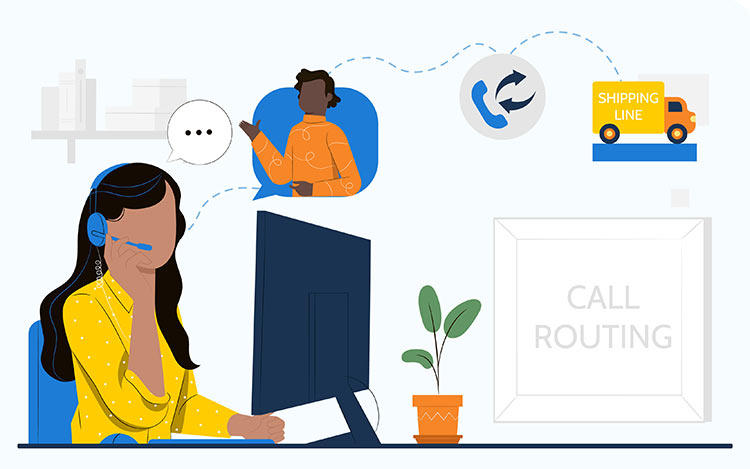What is Call Routing?
Call routing is getting the customer to the right agent rather than the next available contact center agent. The right agent is determined by utilizing information about the customer and the reason to ensure they are routed to the right agent who has the necessary skills, knowledge and abilities to resolve the customer’s inquiry or problem on the first call.
Many contact centers use a generalist agent for call handling to have a large queue of generalist agents to handle calls, however, these agents in many cases are not necessarily matched to address the customer needs, but rather they are the next available agent to take a call. SQM Group’s research shows that in most cases the specialized agents have higher First Call Resolution (FCR) and customer service performance than the generalist agents.
Using call routing technology, a company can route calls based on location, contact reason, line of business, caller repeat call identification, customer personality, dialled number, time-of-day and other customer-defined criteria. Furthermore, call routing can also route callers by language preference, the caller’s geographic location, and the customer's value.
When call routing practices have been determined, calls can be assigned to specific agents based on their skill set. For instance, with call routing, customers who call back within five days can be identified and routed to the best agent within the skill set queue to resolve the caller's inquiry or to the agent who originally handled the call.

Another example is when callers are identified as dissatisfied they can be routed to the best performing FCR and Customer Satisfaction (Csat) agents. This could be done by using Csat survey results and integrating that data into the call routing technology.
SQM’s research has shown that new customers call one to five times within the first 90 days of becoming a customer. In contrast, existing customers call one to three times annually. Therefore, when you consider new customer calling frequency, a best practice is to identify new callers and route them to agents specializing in handling new customer issues (e.g., product information, claim benefits, billing and technical).
It is not uncommon for a contact center that effectively uses call routing technology to significantly improve FCR and Csat. In many cases, FCR and Csat (top box response) increase up to 5%. Furthermore, call duration is also shortened because agents handle calls for which they have the skills. Finally, the cost-per-call resolution will improve because a more knowledgeable agent handles the customer’s call.
Best Practices for Using Call Routing
Best practice tips for using call routing technology are as follows:

New customers – SQM’s research has found that new customers have questions and situations that arise and place up to five calls in the first 90 days of doing business with an organization. Therefore, it is helpful to identify new customers in Customer Relation Management (CRM) and route them to agents with the necessary skills to resolve new customer inquiries and problems. Furthermore, it is crucial to effectively onboard new customers to head off future calls and collect customer information up front to better serve them down the road.

Repeat callers – Callers who have ‘pending resolution’, ‘open cases’, ‘open trouble tickets', or are calling within five days of their previous call, should be identified and routed to a specialized agent to resolve their unresolved call. It is important to note, unresolved calls can create high customer dissatisfaction and defections. Therefore, agents specializing in repeat callers should be empowered to make clear follow-up commitments to the customer to avoid calling back again for further status updates.

High-value customers – Route high-value customers to specialized agents and, if there is competition for these agents’ availability, assign high-value customers a priority in queuing time. High-value customers should be routed to agents with a higher priority than regular customers. Furthermore, these agents should be empowered to provide concierge service to high-value customers.

Default customers – If a customer is identified as being in default of their account (e.g., level to be determined), their call can be routed immediately to an agent in the collections department for making payment arrangements. Moreover, only after acceptable payment terms are reached should the customer be warm transferred to another department agent for further service.

Wait time for customers – In most cases, contact centers struggle with achieving their service level targets. In addition, many repeat calls are driven by callers who abandon the queue to call back at a later time due to poor service levels. By understanding the abandoned thresholds, call routing can script alternate destinations for calls during peak calling hours. For example, all calls in the queue for over two minutes may be routed to an agent who might not be the right match but is suitable. However, the alternative agent skills should be closely matched to the primary servicing skill type to provide the customer with the best service possible. Another best practice is for the customer to be given the choice in the IVR for an automated call back to them (queue placement retained) or the customer can schedule a call back at a specific time that meets their needs.

Defecting customers – If the products and services offered by an organization are highly competitive, it may warrant adding a ‘cancel service’ option to the IVR that front-ends a customer’s call to the contact center. In this way, callers opting for this selection can be routed to agents specialized in ‘retention’ or ‘loyalty’ skills. Furthermore, these agents need to be empowered to make more attractive and competitive service offers to customers.
Quick Related Links
First Call Resolution Definition First Call Resolution PPT First Call Resolution Benefits First Call Resolution Strategies First Call Resolution Operating Philosophy Call Handling Case Study Intelligent Skill-Based Routing CRM Average Speed of Answer Concierge Service Handling Customer Complaints Top 6 Call Handling Best Practices
